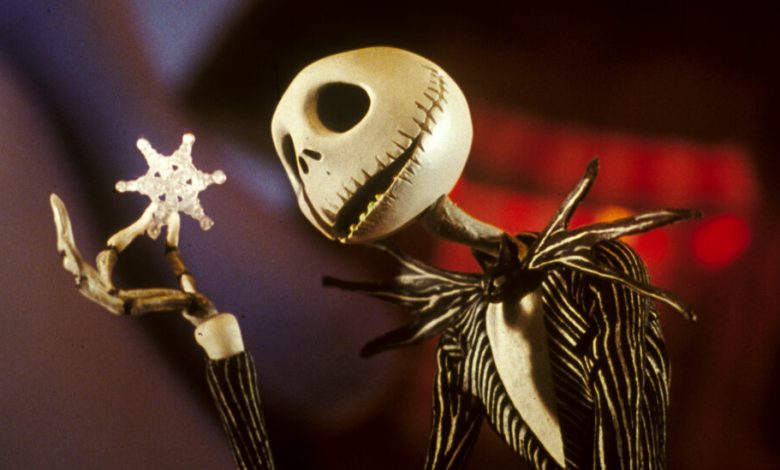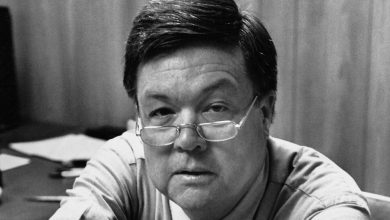‘The Nightmare Before Christmas’: A Hit That Initially Unnerved Disney

“What’s this?” Jack Skellington sings excitedly when he first comes across Santa Claus’s snowy, colorful village in “The Nightmare Before Christmas.” That’s also what Disney executives asked with concern about the idiosyncratic stop-motion animation musical when they saw a rough cut.
“Anytime you’re doing something like that, which was unknown: stop motion, the main character doesn’t have any eyeballs and it’s all music, what’s to feel comfortable about?” Burton said during a video call from London. “Of course they would be nervous about it.”
Burton’s “Nightmare,” currently back in theaters to commemorate its 30th anniversary, is now more popular than ever: This weekend the Hollywood Bowl in Los Angeles is holding a series of live concerts around the film, Disney theme parks feature seasonal attractions inspired by its characters, and merchandise, from board games to housewares, abounds.
But the eccentric and endearing movie wasn’t always a ubiquitous part of our holiday watch list. Back in October 1993, “Nightmare” was released not as a Disney title but under the studio’s more adult-oriented label Touchstone Pictures.
“They were afraid it might hurt their brand,” the director Henry Selick said in a video call from his home in Los Angeles. “If they had put the Disney name on it right then, it would’ve been much more successful, but I understand it just didn’t feel anything like their other animated films.”
Based on Burton’s original story and characters, the unusual picture was directed by Selick, by then a seasoned stop-motion artist with spots for MTV and a variety of commercials to his name. Burton’s frequent collaborators Michael McDowell and Caroline Thompson wrote the screenplay.
Over the course of its original run, “Nightmare” grossed $50 million at the domestic box office. And while that number is by no means dismal, it’s a far cry from Disney animated hits like “Aladdin,” which just a year earlier brought in $217 million from U.S. screens alone.
At the time, Disney couldn’t figure out how to market the operatic saga of Jack, a lanky, sharply dressed skeleton, infatuated with bringing the wonder of Christmas to his monstrous friends in uncanny Halloween Town.
Selick initially worried that the number of songs Danny Elfman had composed for the movie, a total of 10 tracks for the brisk 76-minute run time, would alienate viewers. In retrospect, he said, the memorable tunes were crucial to the film’s eventual success, once audiences connected with its unconventional rules of storytelling and design.
These days Selick can’t go a week without running into a fan wearing a sweater, hat or other apparel emblazoned with “Nightmare” imagery.
“This year there’s a 13-foot-tall Jack Skellington you can buy at Home Depot, and people have them on their lawns,” Selick said. “I like that because it’s pretty bizarre and extreme. That’s not just a T-shirt, that’s a real commitment.”
For Burton, the character of Jack Skellington embodies a preoccupation common in his work over the years: the terrifying notion of being misunderstood. “The conception of it was based on those feelings growing up of people perceiving you as something dark or weird when actually you’re not,” he recalled.
Selick compared the skeletal antihero’s amusingly manic behavior to Mr. Toad from the animated classic “The Wind in the Willows,” one of his favorite Disney protagonists. “I’ve always been drawn to characters like Jack Skellington,” Selick said. “He gets carried away with something new and goes way overboard with his enthusiasm.”
Burton, who grew up in the Los Angeles area, where Latino culture has a strong presence, also holds a special affinity for Día de los Muertos, the Mexican holiday that embraces mortality as a natural part of life’s cycle. That was among his many inspirations for “Nightmare. ”
“I always felt a connection to that celebration. People think of it as a dark sort of thing, but it’s quite light,” Burton said. “That’s where the juxtaposition of those feelings of dark imagery with more spiritual positive feelings connected with me very early in life.”
For stop motion as a technique, “Nightmare” represented a watershed right before the advent of computer-generated animation. Selick credited the director of photography, Pete Kozachik, for introducing the tools that set the production apart, namely designing and building the rigs that allowed the heavy Mitchell film cameras to move a frame at a time.
“That made the film so cinematic,” Selick said. “All the stop motion before had been done in lock shots or really simple little pans,” the mostly static visual language that limited other stories told in the same medium. But, Selick continued, “what Pete brought was this freedom of camera movement, which really turned it into a bigger movie.”
While there was talk of turning his concept for “Nightmare” into a TV special or realizing it in hand-drawn animation, Burton — who as a child adored Ray Harryhausen’s creations and Rankin/Bass tales like “Rudolph the Red-Nosed Reindeer” — held out until there was a team to do it in stop motion.
“If you’ve ever been on a stop motion set and you see its tactile beauty, it is like going back to the beginning of making movies in the sense that it’s all about artists making puppets, sets, there’s a feeling that’s unlike any kind of thing,” Burton said.
Decades before he directed the stop-motion features “Corpse Bride” (2005) and “Frankenweenie” (2012), both of which earned him Oscar nominations for best animated feature, Burton dove into the painstaking technique with a 1982 short film, “Vincent.”
“Other mediums are great, but for me that’s the most pure and beautiful one,” Burton added.
Selick admitted that for a while the general public’s lack of awareness that he had directed “Nightmare” upset him. He’s now made peace with the lack of credit because this milestone in his career wouldn’t have happened without “Tim’s brilliance and ideas.”
“I could still certainly win bar bets for the rest of my life,” he said with a cheeky smile. “‘For $20, who directed ‘The Nightmare Before Christmas’?”
For Selick, one of the indicators that the movie had become a classic came a few years after the lukewarm reception to the theatrical release, but before Disney had fully embraced it. The director recalls children coming to his house trick-or-treating on Halloween night in homemade costumes of “Nightmare” characters before officially licensed versions existed.
“I’d sometimes bring them in with their parents and show them the original figure of Jack as Santa in his sled with the reindeer that I kept, and they would just scream with joy,” Selick recalled while pointing his camera to the fragile figure in a glass display case.
“It’s not really mine or Tim’s or Danny’s anymore,” Selick said. “It’s the world’s movie, and I kind of like that.”
Since 2001, the Haunted Mansion ride at Disneyland has been transformed every fall into a “Nightmare”-inspired attraction known as Haunted Mansion Holiday. And each year, from early September through October, Disneyland holds the Oogie Boogie Bash, a Halloween party three nights a week featuring and named after the movie’s rambunctious villain.
Burton believes these displays epitomize the film’s evolution from unclassifiable oddity to a uniquely beloved property. “When I see that, I go back to the early days when the film was first being done, and thinking of the journey that it’s taken, this symbolizes it in a very strange way,” said Burton.
Selick added that he was invited the first year of the Haunted Mansion Holiday. “They didn’t try to turn it into one of their other characters,” he said. “They really got the aesthetic of the designs just right.”
A sequel novel, “Long Live the Pumpkin Queen,” focused on Jack’s romantic partner, Sally, and a prequel comic, “The Battle for Pumpkin King,” were published in the last year. Yet three decades on, Burton maintained that the original animated film was a one-of-a-kind feat.
“In a certain way that’s the beautiful thing about it as it is. It’s one movie. It’s stop motion and it tells its story. And that helps make it special for me,” Burton explained. “It’s its own thing, there aren’t five sequels and there’s not a live-action reboot.”




